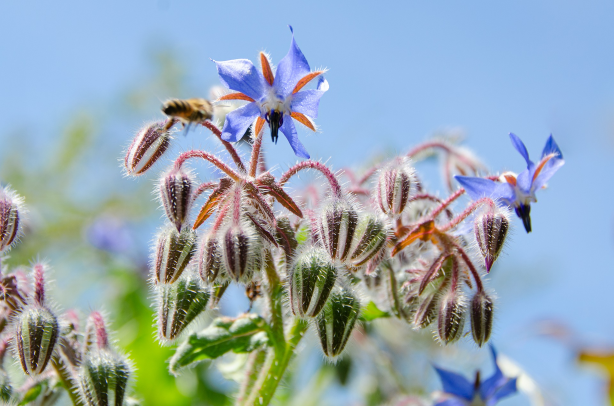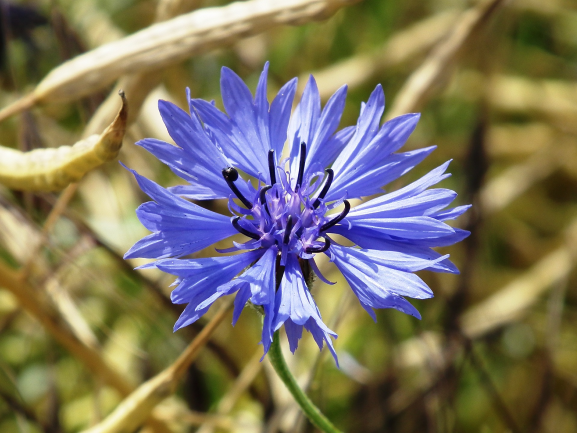As I discussed last week, people around the world have been using flowers in their cooking and medicinally for thousands of years. And today, I’m going to discuss new research into two more edible flowers—borage (Borago officinalis) and centaurea (Centaurea cyanus). It turns out, these flowers are good sources of much-needed nutrients, including vitamin E. Let’s dive right in…
Humans have been cultivating healing flowers for thousands of years
Borage, also known as star flower, is an annual, flowering plant indigenous to parts of the Mediterranean region. Its flowers are typically blue, white, or pink. (Like many flowering plants, such as hydrangea, its color responds to the pH of the soil. Alkaline soil yields blue-purple, acidic soil yields pink, and neutral soil yields white.)
Medicinally, borage has a variety of traditional uses. You can grind up the petals (or use borage seed oil) to make a cleansing wash to treat eye and skin infections. Or you can make a tea with the petals to take as a tonic for indigestion.
Borage petals are also commonly used in cooking—as they taste a bit like cucumbers. And the stamens (the little stalks at the center of the blossoms) carry a hint of sweetness.

(Image by Katharina N. from Pixabay)
In addition, centaurea, commonly known as cornflower, is another annual, flowering plant with a long history of medicinal use. In fact, according to Greek mythology, centaurea was used to heal a wound inflicted on Achilles by Heracles. And throughout history, it’s been widely used to treat fever, constipation, water retention, and chest congestion.
For centuries, centaurea was most commonly found growing wild in corn fields (hence its name). But now, thanks to the widespread use of pesticides, we see less of it growing in the wild. Although, I do still see them growing along roadways and at the edges of lawns and flower beds during summer. Cornflower blue is even a popular color for paint in New England.

(Image by Sabine Löwer from Pixabay)
Most recently, both these flowers have garnered the interest of the scientific world. And scientists from Portugal have begun to study their nutrient content…
Edible flowers high in vitamin E
For the new study, food scientists from two universities in Portugal analyzed the nutrient composition of borage and centaurea petals at different stages of flowering. Specifically, they looked at calories, carotenoids, carbohydrates, essential fatty acids, fats, fiber, and tocopherols (active compounds that make up vitamin E) contained in each petal.
Overall, they found that the nutrient content of both flowers was quite similar. But borage had higher amounts of carotenoids and essential fatty acids, while centaurea had more calories (energy) and fiber.
Plus, borage and centaurea both contain significant amounts of vitamin E (primarily alpha-tocopherol)—a much-misunderstood vitamin that we don’t hear much about. (You can learn more about E in the July 2014 issue of Insiders’ Cures [“FDA guidelines and faulty research obscure vitamin E’s true healing potential”].)
Overall, eating these flowers daily can boost your intake of vital nutrients. And you can even grow them in your own backyard!
Simply gather the blossoms early in the morning, before the flowers open. Then, you can grind up the petals to make tea. Or eat them fresh, fried, or added to soups and stews. You may even want to make a topical ointment with the dried petals, as was used on Achilles.
Just make sure to avoid using flowers purchased from florists, garden centers, and nurseries—since they’re typically treated with pesticides and not labeled for food use.
And remember—not all flowers are safe for consumption. So, be sure to check out the March 2020 issue of my Insiders’ Cures newsletter to learn more about six more safe-to-enjoy flowers, their medicinal uses, and how to prepare/consume them (“Six flowers that can combat everything from obesity to anxiety”). If you’re not yet a subscriber, now is the perfect time to get started.
Sources:
“Edible flowers can contribute to daily dose of vitamin E, study suggests.” Nutraingredients, 8/15/19. (nutraingredients-latam.com/News/Research/Edible-flowers-can-contribute-to-daily-dose-of-vitamin-E-study-suggests#)
“Phytochemical characterization of Borago officinalis L. and Centaurea cyanus L. during flower development.” Food Research International, September 2019; 123: 771-778. doi.org/10.1016/[.foodres.2019.05.014
“The pharmacological importance of centaurea cyanus – a review.” Pharmacy Review & Research, January 2015; 5(4): 379-384.
